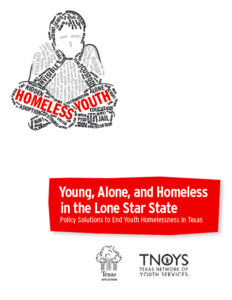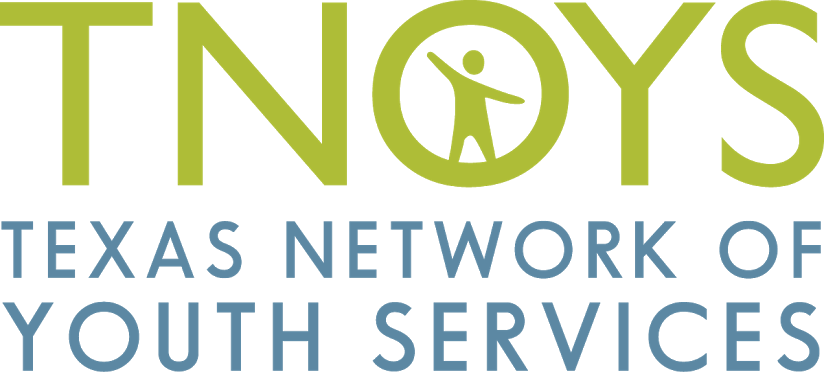 Last week, TNOYS and Texas Appleseed released the most comprehensive study to date on the issue of youth homelessness in Texas. “Young, Alone and Homeless in the Lone Star State” sheds light on the situation of youth experiencing homelessness in our state, and also provides recommendations on policies that can help them. The report has already received an extensive amount of state and national media coverage, and it is encouraging to see this important issue receiving attention that has the potential to lead to real change.
Last week, TNOYS and Texas Appleseed released the most comprehensive study to date on the issue of youth homelessness in Texas. “Young, Alone and Homeless in the Lone Star State” sheds light on the situation of youth experiencing homelessness in our state, and also provides recommendations on policies that can help them. The report has already received an extensive amount of state and national media coverage, and it is encouraging to see this important issue receiving attention that has the potential to lead to real change.
Here are some of the news stories that have run about the report so far:
- Texas Tribune: Texas’ Homeless Youth Slip Through Cracks of Disjointed Support System, New Report Says
- The Rivard Report: New Study Sheds Light on Challenges Facing State’s Homeless Youth
- San Antonio Express-News: Homeless youth in Texas not getting help they need, advocates say
- Houston Chronicle: Study: The Needs of Homeless and Runaway Youth in Texas Going Unmet
- Houston Chronicle: 25 Duties (editorial)
- KLBK: Report: State Should Form Task Force to Tackle Youth Homelessness
- NPR: New Study Finds 42 Million Kids Experience Homelessness Each Year
The key finding of the report is that the lack of a cohesive policy and funding approach to address the problem of youth homelessness in Texas has resulted in high levels of youth who are homeless and poor outcomes for these young people. The report reveals that youth homelessness doesn’t just affect youth who find themselves without homes, it also has broader implications for the communities in which they live because of the impact on the criminal justice systems, education, and other key institutions.
For example, young people who are homeless are more likely than their housed peers to be victims of crime. At the same time, behaviors associated with youth homelessness — including running away from home and foster care placements — are too often criminalized, and actions linked to lack of secure housing (curfew violations, vagrancy, panhandling, camping) are punished as violations of the law.
There are many solutions to help address this. For example, both Austin and Houston are called out in the report for having created units within their municipal police departments that are specially trained to respond to those who are homeless and prioritize connecting people with social services rather than relying on a traditional law enforcement model. The advantage of this training is that it reduces the criminalization of survival behavior associated with youth homelessness.
The report also reveals that Texas schools are on the front lines of this issue, representing enormous potential for prevention and intervention. A bright spot in the findings relates to the promise schools hold for connecting young people with services and supports, and the remarkable work that school-based homeless liaisons and private service providers are doing. For example, In the 2014-15 school year, more than 113,000 Texas public school students were identified as being homeless at some point during the school year – a 12 percent increase from the 2013-14 school year. The increase is likely due to better efforts to identify students.
The report is based on nearly 200 interviews with young people who have experienced homelessness, service providers in schools, law enforcement officials, foster care system representatives and other voices. It builds on previous research efforts led by TNOYS, including the Youth Count! Texas project and our recent report on homeless student liaisons working within the public education system.
The report’s release came during National Runaway Prevention Month and also occurred on the same day as the release of a report by Chapin Hall at the University of Chicago that provides a national perspective on the issue of youth homelessness. Together, these efforts suggest a growing momentum behind the effort to better understand and address the challenges facing some of our most vulnerable young people. We are encouraged by the attention the report has received and are hopeful that it will lead to better support for youth experiencing homelessness.
